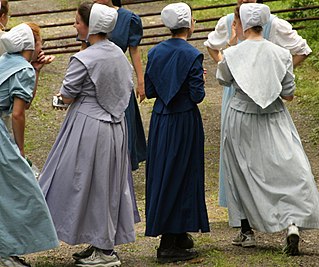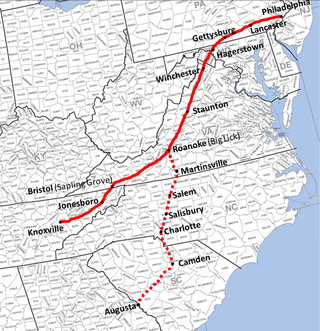
Kalona is a city in Washington County, Iowa. It is part of the Iowa City metropolitan area. The population was 2,630 at the time of the 2020 census. Kalona is the second-largest city in Washington County.

Plain people are Christian groups characterized by separation from the world and by simple living, including plain dressing in modest clothing. Many Plain people have an Anabaptist background. These denominations are largely of German, Swiss German and Dutch ancestry, though people of diverse backgrounds have been incorporated into them. Conservative Friends are traditional Quakers who are also considered plain people; they come from a variety of different ethnic backgrounds.

The Old Order River Brethren are a River Brethren denomination of Anabaptist Christianity with roots in the Radical Pietist movement. As their name indicates, they are Old Order Anabaptists.
Old Order Mennonites form a branch of the Mennonite tradition. Old Order are those Mennonite groups of Swiss German and south German heritage who practice a lifestyle without some elements of modern technology, still drive a horse and buggy rather than cars, wear very conservative and modest dress, and have retained the old forms of worship, baptism and communion.
Barbara Heinemann Landmann was a spiritual leader with the Community of True Inspiration, for which she served as Werkzeug, or Instrument, in both Europe and the United States. Her sermons and writings are still used during the Community's religious services.
The New Order Amish are a subgroup of Amish that split away from the Old Order Amish in the 1960s for a variety of reasons, which included a desire for "clean" youth courting standards, meaning they do not condone the practice of bundling during courtship. Tobacco and alcohol are also not allowed. They also wished to incorporate more evangelical elements into the church, including Sunday school and mission work. Some scholars see the group best characterized as a subgroup of Old Order Amish, despite the name.
The Mennonite Historical Library (MHL) is considered the world's most prominent and complete collection of resources and artifacts pertaining to Mennonites and related Anabaptist groups. It is housed in the Harold and Wilma Good Library on the campus of Goshen College in Goshen, Indiana. The specialty library was founded in 1906 under the guidance of Harold S. Bender and Ernst Correll. Historian John D. Roth is the current director.
Amish Mennonites came into existence through reform movements among North American Amish mainly between 1862 and 1878. These Amish moved away from the old Amish traditions and drew near to the Mennonites, becoming Mennonites of Amish origin. Over the decades, most Amish Mennonites groups removed the word "Amish" from the name of their congregations or merged with Mennonite groups.
Located in Smithville, Ohio, Oak Grove Mennonite Church is an historical church that has made a significant contribution to the larger Mennonite denomination, currently pastored by Doug Zehr. Oak Grove started as an Amish church in 1818, as many Amish started settling in Wayne County, Ohio. From humble beginnings the church grew and built a meetinghouse in 1862, one of the earliest of such meetinghouses the Amish have built.

Julia Mae Spicher Kasdorf is an American poet.
John A. Hostetler was an American author, educator, and scholar of Amish and Hutterite societies. Some of his works are still in print.

The Amish, formally the Old Order Amish, are an ethnoreligious group with Swiss German and Alsatian origins. Consisting of several Anabaptist Christian church fellowships, they are closely related to Mennonites, a separate Anabaptist denomination. The Amish are known for simple living, plain dress, Christian pacifism, and slowness to adopt many conveniences of modern technology, with a view neither to interrupt family time, nor replace face-to-face conversations whenever possible, and a view to maintain self-sufficiency. The Amish value rural life, manual labor, humility and Gelassenheit. As they rarely accept converts, maintain a separate language and culture from surrounding populations, and hold their faith in common, they have been described by scholars as an ethnoreligious group, combining features of an ethnicity and a denomination.
Guy F. Hershberger was an American Mennonite theologian, educator, historian, and prolific author particularly in the field of Mennonite ethics.
Troyer is a last name of German origin which is widespread among the Amish, Brethren and the Mennonites. It is the Pennsylvania German form of the German last name "Dreier", "Dreyer", "Treyer" or "Dreher". A Dreher in German is a traditional operator of a rotating cutting machine.
Over the years, as Amish churches have divided many times over doctrinal disputes, subgroups have developed. The "Old Order Amish", a conservative faction that withdrew in the 1860s from fellowship with the wider body of Amish, are those that have most emphasized traditional practices and beliefs. There are many different subgroups of Amish with most belonging, in ascending order of conservatism, to the Beachy Amish, New Order, Old Order, or Swartzentruber Amish groups.
College Mennonite Church (CMC) is a Mennonite Church located in Goshen, Indiana, and a member of the Indiana-Michigan Mennonite Conference of Mennonite Church USA.

The Kauffman Amish Mennonites, also called Sleeping Preacher Churches or Tampico Amish Mennonite Churches, are a plain, car-driving branch of the Amish Mennonites whose tradition goes back to John D. Kauffman (1847–1913) and Noah Troyer (1831–1886) who preached while being in a state of trance and who were seen as "sleeping preachers".
A sleeping preacher, also called trance-preacher, is a Christian, most often Protestant person who preaches, prophesies or addresses a public audience while "sleeping," that is, in a state of trance.
John D. Kauffman was an Amish Mennonite minister and later bishop who preached while being in a state of trance and who was seen as a "sleeping preacher". The Kauffman Amish Mennonites, a group with about 3,500 members, still adhere to his teachings.

The Shenandoah Valley region of Virginia and parts of West Virginia is home to a long-established German-American community dating to the 17th century. The earliest German settlers to Shenandoah, sometimes known as the Shenandoah Deitsch or the Valley Dutch, were Pennsylvania Dutch migrants who traveled from southeastern Pennsylvania. These German settlers traveled southward along what became known as the Great Wagon Road. They were descendants of German, Swiss, and Alsatian Protestants who began settling in Pennsylvania during the late 1600s. Among them were German Palatines who had fled the Rhineland-Palatinate region of southwestern Germany due to religious and political persecution during repeated invasions by French troops.






